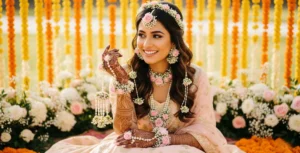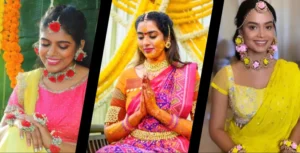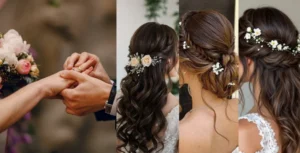A South Indian wedding is a deeply spiritual and traditional affair, marked by various poojas (rituals) that seek divine blessings for the couple’s married life. Each ritual involves specific pooja items, each with its significance.
Pooja Items Needed for a South Indian Wedding range from sacred vessels to fragrant flowers, each playing a crucial role in upholding the sanctity of the wedding. Below is a detailed list of essential pooja items and their importance and usage.”
List 10 of Pooja Items Needed for a South Indian Wedding
1. Deepam (Oil Lamps)

All major wedding rituals include the lighting of Oil Lamps or Deepams because these lamps represent knowledge as well as positive energy which removes darkness from the world. A lamp lighting represents divine power and creates clarity while providing wisdom for the new life of the couple.
The lamp finds its placement next to the pooja altar where it burns continuously from the beginning to the end of the marriage ceremony. Through this custom the bride brings a glowing oil lamp into her new house, which symbolizes wealth together with happiness for her marital future.
2. Holy Scriptures and Mantra Books

South Indian Wedding Traditions hold deep spiritual significance, relying on Vedic scriptures and sacred texts. During the ceremony, the priest chants powerful mantras, invoking divine blessings to guide the couple through marital and spiritual practices. These Vedic hymns create a sacred atmosphere, leading the newlyweds toward a life of harmony and spiritual fulfillment.
Families who maintain religious texts including the Bhagavad Gita and Lalitha Sahasranamam, position them next to the mandap to strengthen the holy nature of the ceremony. Religious scriptures support the new couple because they ensure a spiritual start and bless them with divine grace at their wedding.
3. Rice and Akshata (Unbroken Rice Grains)

The Hindu religious tradition places great importance on rice because it represents a good harvest and successful reproduction. The custom of using unbroken rice grains called Akshata appears in various poojas to grant the newlywed couple success in life. The couple welcomes Akshata from the elders, who represent blessings for a happy marriage.
Wedding participants exchange rice grains through ritual exchange symbolizing their readiness to partner in family life responsibilities and nurturing their offspring. To strengthen their requests for a happy and wealthy future, the couple offers rice to hailed deities.
4. Sandalwood Paste (Chandanam)

The cooling and aromatic sandalwood paste functions extensively across South Indian wedding ceremonies. The bridal couple receives sandalwood paste on their foreheads during the wedding ceremony because it functions to attract divine blessings and prevent panic throughout the ceremony. The calming aroma of sandalwood is considered to cleanse the spiritual energy around people while generating a holy environment.
Moreover, the ritual requires people to apply sandalwood paste to all religious items, including idols, along with the Kalasham object. The paste symbolizes both purity and spiritual awakening, as well as blocking dangerous energy forces. The cooling sensation of the paste symbolizes both patience and harmony which form essential qualities for a fruitful marriage.
5. Flowers (Jasmine, Marigold, and Roses)

Flowers serve as fundamental elements in pooja items needed for a South Indian Wedding because they bring sacred blessings as well as beauty and pleasant scents during holy rituals. The wedding tradition uses Jasmine as a floral symbol which both parties exchange in their hair and as formal neck and head decorations. Marigold holds symbolic value for prosperity thus it gets employed for decorating both the mandap and pooja altar.
Traditional customs in blessings and rituals use rose petals to symbolize love, together with happiness. Fresh floral arrangements, along with garland, are prepared at the start of the wedding to boost the holy nature of the celebration through their positive energy. Flowers bring both enchanting scents and beautiful hues that together create an extraordinary, sacred atmosphere which wedding pooja items greatly depend on.
6. Sacred Threads (Mangalasutra and Kankanam)

“In South Indian weddings, the ‘Mangalasutra’ is also known as ‘Thali’. The Importance of Thali in South Indian Wedding is deeply rooted in tradition and culture. During the ceremony, the bride receives a holy Mangalasutra necklace from her groom, making it the primary sacred thread. The Mangalasutra stands for the sacred marital union and functions as an enduring symbol of protection, together with the vow of lifelong union. It signifies love, commitment, and the blessings of a prosperous married life.”
At the start of the ceremony the Kankanam yellow sacred thread gets tied to both the bride and groom on their wrists. The thread possesses two sacred meanings that represent protective powers alongside a dedication to divine entities. The ritual involves soakage of the thread in turmeric water to boost its sacred properties and provide blessed beginnings for the married life of the couple.
7. Turmeric (Manjal) and Kumkum

Turmeric, a sacred spice, plays a vital role in Hindu traditions, especially weddings. Through tradition, turmeric is tied to purity along with protective powers, and it supports fertility. Before a wedding the bride uses turmeric paste both on her feet and hands for beauty enhancement while receiving natural antiseptic benefits. The groom performs turmeric-based rituals to show readiness for marriage as well as purity.
Kumkum represents an auspicious symbol that combines turmeric extract with lime paste for application on the forehead. The application of turmeric paste on the bride represents her devotion to marriage while symbolizing eternal bliss and indicating that Goddess Lakshmi stands with them. Through daily use of kumkum on their foreheads, married women bring prosperity into their lives, and at weddings, it plays a central role in blessing new couples to create a life of prosperity and happiness.
8. Betel Leaves and Areca Nuts (Tambulam)

The essential component Tambulam, consisting of areca nuts and betel leaves holds its place during South Indian wedding ceremonies. These symbolize respect, goodwill, and fertility. Religious guests, along with deities, receive these leaves as a sign of respect, which family members also give each other to show their commitment to strengthening the family connection between both sides.
After the wedding ceremonies, various traditions provide the couple with betel leaves together with nuts to symbolize the start of their new life with positive energy. Participants receive Ayurvedic advantages when using this tradition because it helps digestion and brings general wellness benefits. Tambulam, incorporated within the pooja items, enhances the blessed character of the festivities.
9. Kalasham (Sacred Pot)

A sacred metal pot called the Kalasham combines water with mango leaves and coconut to signify prosperity, along with purity and divine power. The deities get invited through the Kalasham that stands proud at the heart of the wedding altar during every ritual in the ceremonies. The sacred water within the pot receives spiritual power through which priests later scatter it to cleanse the wedding area and to bless the couple.
The Kalasham serves both religious and cultural purposes as it signifies marital abundance while also representing new beginnings for a prosperous family life. The item receives additional blessings by receiving applications of turmeric, kumkum, and sandalwood paste. Throughout the wedding ceremony the priest performs chanting of holy mantras while providing flowers to Kalasham to invoke divine blessings for both a happy and peaceful union.
Visit our Instagram page for more details
10. Coconut

Coconut maintains strong religious importance in South Indian wedding ceremonies because it stands for three crucial ideas of purity and selflessness, as well as divine blessings. This sacred object gets utilized in wedding rites by serving to break coconuts for protection against evil entities before setting them towards divine beings. The exterior shell symbolizes tolerating challenges, yet the inner sweet liquid symbolizes how dedication leads to blessings.
As a representation of his devoted love the groom provides a coconut to the bride’s family when celebrating their marriage ceremony. The coconut serves to reinforce the sacred essence of the Kalasham when it is placed upon it. The custom of exchanging coconuts exists during Kanyadaan for certain Indian wedding traditions, which represent the start of their joint future.
Conclusion
In conclusion, a South Indian wedding is a blend of rituals, devotion, and traditions, with each pooja item holding deep spiritual significance. The list of Pooja Items Needed for a South Indian Wedding includes sacred items that not only enhance the sanctity of the ceremony but also symbolize prosperity, love, and divine blessings. Understanding the importance of each pooja item helps in preserving the rich cultural heritage of South Indian weddings and ensures that every ritual is performed with the utmost reverence and authenticity.
FAQ
How should the pooja items be arranged on the wedding altar?
The pooja items should be arranged in a clean and organized manner on the mandap. The Kalasham is placed at the center as it symbolizes divine presence. Sacred items like coconut, turmeric, kumkum, and betel leaves are placed nearby. Flowers and garlands are kept fresh, and oil lamps (Deepam) should be lit before the rituals begin. Each item should be positioned according to its use in the ceremony to ensure smooth execution of the rituals.
Can modern substitutes be used for traditional pooja items?
While traditional items hold deep cultural significance, modern substitutes can be used when necessary. For example, artificial flowers may be used if fresh flowers are unavailable, and ready-made kumkum or turmeric powders can replace freshly ground ones. However, it is always recommended to use natural and authentic pooja items to maintain the sanctity of the rituals.
How can pooja items be preserved and reused after the wedding?
Some pooja items like Kalasham, sacred threads, and oil lamps can be preserved and used for future religious ceremonies. Flowers and coconuts should be disposed of respectfully in water bodies or composted. Items like turmeric, kumkum, and betel leaves can be stored for later use in daily prayers. Proper storage in clean, dry containers helps maintain their purity.





